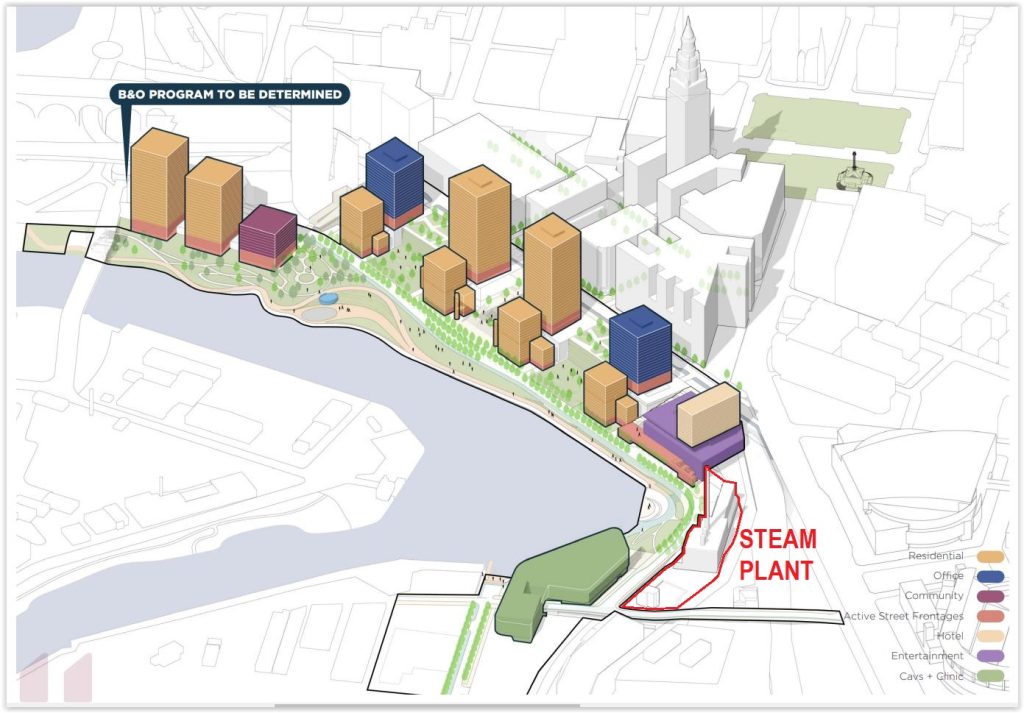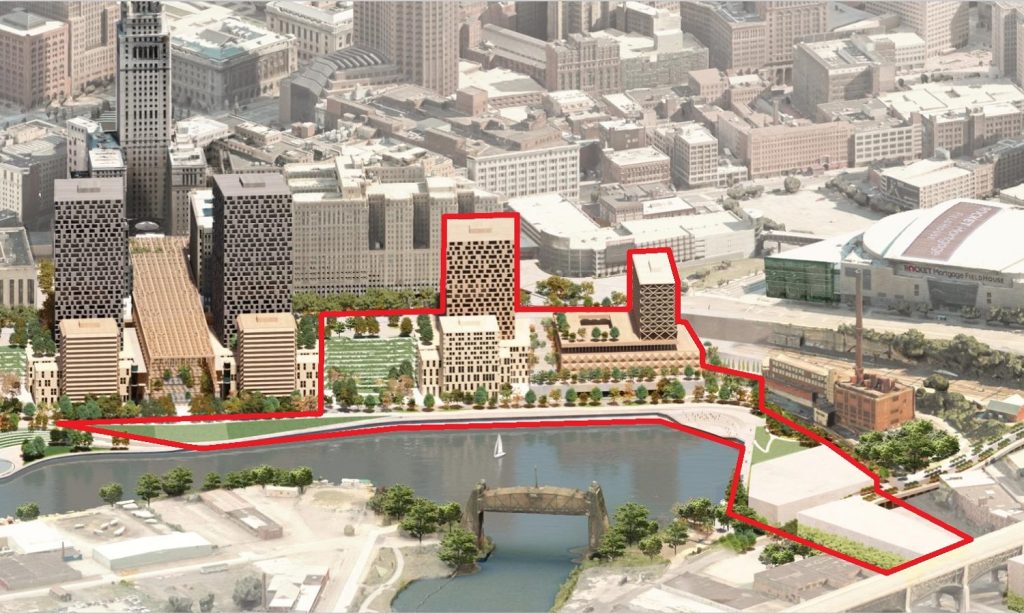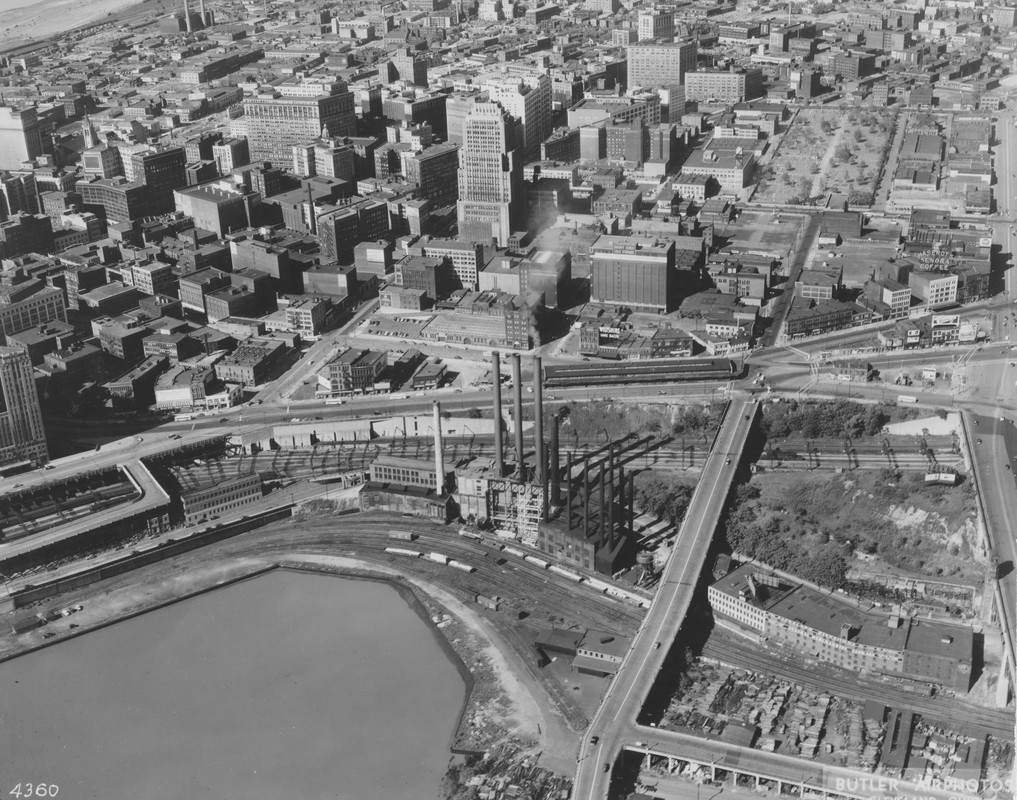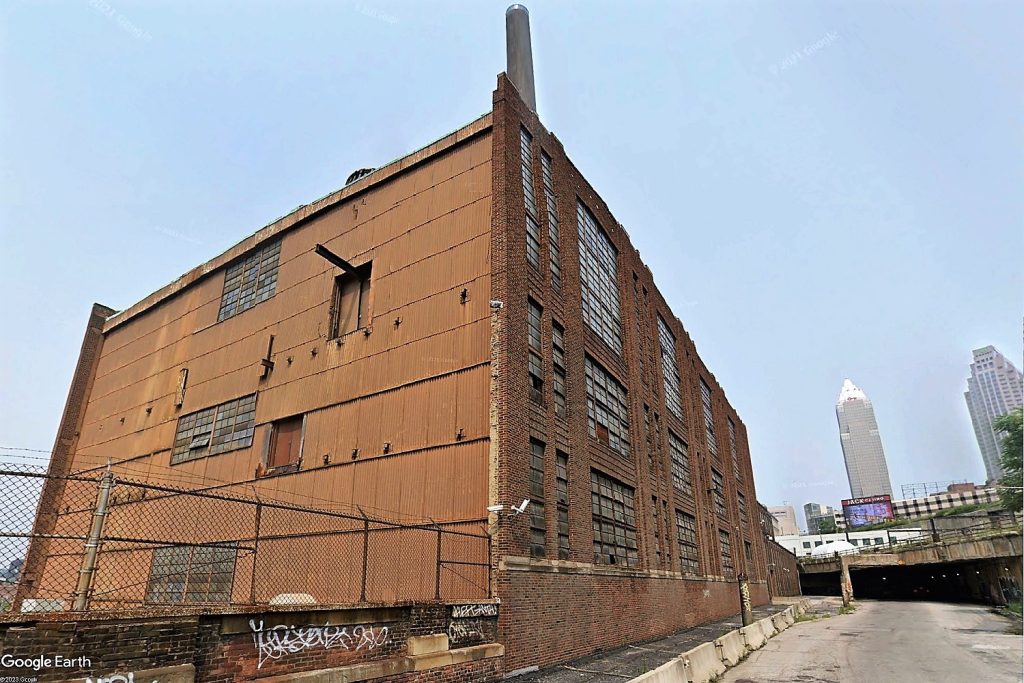
Bedrock Real Estate wants to demolish at least part of this closed steam heating plant for its Riverfront redevelopment in Downtown Cleveland. The fate of the four-story building in the foreground remains unclear. Meanwhile, the Greater Cleveland Regional Transit Authority plans to refurbish its Canal Road overpass, at left, as early as next year (Google). CLICK IMAGES TO ENLARGE THEM.
Most of site to be in downtown mixed-use district

If you like what Bedrock Real Estate has planned for its huge Riverfront Development in Downtown Cleveland, expect more of it at the site currently occupied by closed Cleveland Thermal steam heating plant, 2274 Canal Rd. That’s what public records reveal in the application for Ohio Brownfields Program funding that was awarded last week. But not all of the steam plant may be affected.
Cuyahoga Land Bank was granted $2.5 million to help offset $4.9 million worth of demolition and site clean-up costs at Cleveland Thermal, an antiquated plant that has stood since 1894, but was significantly upgraded in 1946, property records show. The coal-fired plant closed in 2016.
Although Cuyahoga Land Bank was the applicant for the Brownfield funds, the sub-applicant was Canary Acquisition Company LLC, according to its funding application. Canary Acquisition is an affiliate of Detroit-based Bedrock Real Estate.
State funds will be used to remove asbestos and other hazardous materials on the 1.5-acre property, demolish all of the structures on that parcel and cap the former heating plant site with new, clean soil to be brought in, the application noted. An attached, four-story brick building on a separate parcel measuring one-third of an acre is not part of the Brownfields application.

The steam plant at the Cuyahoga River’s Collision Bend physically separates the initial phases of Bedrock Real Estate’s Riverfront development from each other. Although public spaces along the water’s edge will help provide some connective tissue (Bedrock).
“The first step toward productive reuse is to get rid of what’s not productive,” said Vince Adamus, environmental project manager for the Cuyahoga Land Bank. “I’m not aware of any individual or group looking at this (heating plant) as a creative reuse. It may not be practical because of its prior use.”
Burning coal releases into the air and soil various pollutants including sulfur dioxide, nitrogen oxides, particulates, carbon dioxide, mercury and other heavy metals. These emissions contribute to various environmental and health problems, according to the U.S. Energy Information Administration.
Replacing the steam plant will be a “future mixed-use commercial development consistent with other investments underway,” noted Bedrock’s application narrative. Preliminary plans are for public realm and public infrastructure improvements for new offices, retail, food, beverage, entertainment and parking, it added.
Adding this site and its proposed reuse to Bedrock’s 35-acre Riverfront Masterplan, approved by the City Planning Commission in February, will likely require a vote by the commission to amend it. The first phases of implementing that masterplan are located on either side of the steam plant.
The first structure to be built in Bedrock’s $3.5 billion riverfront masterplan is immediately south of the steam plant — the 210,000-square-foot Cleveland Clinic Global Peak Performance Center. Construction began last fall on the $200+ million building and is scheduled to be completed in 2027.
The Cleveland Clinic facility will offer comprehensive care for the general public, including athletes of all sports and levels, with access to testing and high-tech training equipment and devices. And it will be the relocated practice facility for the Cleveland Cavaliers basketball team. Their current facility is in suburban Independence.
On the other side of the Cleveland Thermal plant, Bedrock is continuing to nail down financing for its $488 million Rock and Roll Land entertainment complex. Located off West Huron Road, the 560,017-square-foot structure is planned to include a 268,452-square-foot parking garage for approximately 800 cars, topped by a theater and hotel totaling 17 stories tall.
Last January, Bedrock won $9.1 million in Transformational Mixed-Use Development (TMUD) tax credits from the state for Rock and Roll Land. But it requested $40 million from the Ohio Department of Development which administers the TMUD program.
Unless the TMUD program is renewed by the Ohio General Assembly or some prior TMUD awards are not used and redistributed, no new TMUD awards will be made. But layers of funding are typical for projects of this size.
In order to secure the Ohio Brownfield Program grant, the applicant or sub-applicant had to have site control of the affected property, such as a purchase agreement with the current property owner Corix Cleveland Thermal Generating LP.
Bedrock began the process of acquiring the steam plant, first by incorporating Canary Acquisition Company LLC in May 2023. NEOtrans wrote about the potential acquisition soon thereafter. The buyer was not identified by the source who tipped off NEOtrans.
In September, a certificate of disclosure was requested from the Cleveland Building Department for the steam plant property by a title company as part of a pending title transfer. Again, the buyer was not identified in the disclosure, only the property’s legal history was.
In February 2024, the steam plant property’s title transferred from Cleveland Thermal Generation LLC to Corix Cleveland Thermal Generating LP for $2,036,711. But Canadian-based Corix had already acquired Cleveland Thermal nine years earlier. The deed transfer followed the creation of Canary Acquisition, suggesting the transaction may be as part of an entity sale rather than as a deed transfer.
However, the grant application affects only the parcel on which a 78,480-square-foot structure housing the coal-fired boilers are located. A four-story, brick office building attached to the steam plant and measuring 37,160 square feet is not part of the Brownfield remediation work. It sets on a separate parcel owned by FirstEnergy Corp.
There are no public records indicating that this property will be part of the Bedrock redevelopment, such as deed transfers or a predecessor document like a certificate of disclosure.
Adamus confirmed that the Cuyahoga Land Bank’s Brownfield application does not include the FirstEnergy parcel. But he said the property might still be part of the demolition even if no Brownfield funding will be directed to it for remediating it.
Lora Brand, vice president of communications at Bedrock, did not respond to an e-mail from NEOtrans prior to publication of this article seeking more information about the company’s plans for the steam plant site.
The four-story brick building was built by a FirstEnergy ancestor, the Cleveland Electric Illuminating Company (CEI) more than a century ago.
“As Cleveland emerged as an industrial powerhouse in the late 19th century, the Cleveland Electric Illuminating Company established the Canal Road plant along the Cuyahoga River,” wrote Corix Chief Development Officer Diego Mandelbaum on LinkedIn.
“Originally designed for electricity generation, the plant’s engineers had the foresight to repurpose waste steam to heat nearby buildings, laying the foundation for one of North America’s earliest district energy systems,” he added.
Built around east side of the steam plant in the late 1920s was the Cleveland Union Terminal railroad. It was constructed atop a unique shelf-like bridge over Canal Road. Sometimes, especially on rainy nights, this underpass is flooded and dark, making for an unnerving passage.
Today, the Greater Cleveland Regional Transit Authority’s (GCRTA) rapid transit lines to the eastern suburbs travel across this bridge. As early as 2026, GCRTA intends to rehabilitate the bridge for $6.4 million. Canal Road will be repurposed by Bedrock as an access road to parking and loading docks in its Riverfront development.
To meet growing demand, CEI expanded in 1924 with a second steam plant at East 20th Street and Hamilton Avenue. This facility complemented the original Canal Road station. CEI sold its steam plant interests to Cleveland Thermal Energy Corp. in 1987. This sale was part of a resolution to an eight-year dispute with Cleveland State University over steam rates.
In 2015, shortly after Corix acquired Cleveland Thermal, it invested $25 million to convert the Hamilton plant from coal to natural gas, cutting carbon-dioxide emissions by 84 percent. The plant serves more than 90 buildings in Downtown Cleveland.
END








